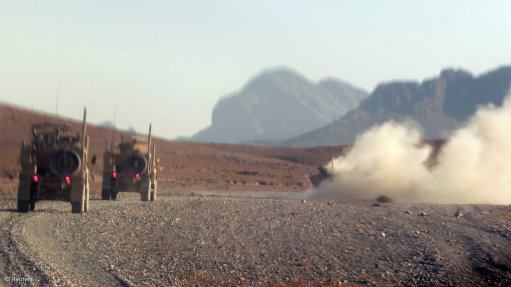
Photo by: Reuters
The Council for Scientific and Industrial Research (CSIR) has successfully developed a counter-improvised explosive device (IED) shaped charge protection system for vehicles. This was reported on Thursday at the CSIR Conference in Pretoria by Rayeesa Ahmed, research group leader for protection and survivability systems.
The project was to develop a system that would provide protection against a medium-sized explosively-formed projectile (EFP) IED threat. EFPs, also called explosively-formed penetrators, are the IED equivalent of shaped charges in regular munitions. Both operate on the same principle of focusing the power of an explosion. A metal liner, usually cone- or dish-shaped, is placed in front of the explosive charge and when the explosive is detonated this liner focuses the explosion and becomes a metal "slug" that is shot at the target at a very high velocity. Because the energy of the explosion is focused, an IED that produces an EFP can do much greater damage to an armoured vehicle than one that just produces blast effects.
"IEDs have become the number one choice of attack by insurgents," she pointed out. This applied to Africa as well. "We're looking at an average of 38 [IED] detonations a month, in Africa."
For the CSIR team, a medium-sized EFP is one produced by an IED with a diameter of 120 mm. "To define the protection solution, you need to characterise the threat," she pointed out. "No two IEDs are the same." So the team had to design and develop surrogate EFPs, so that they could reliably repeat the threat, for test and development purposes.
The key characteristics of EFPs are their mass, speed and shape. "A good solution needs to be able to break up or change the shape of the projectile, or slow it down," she explained. Achieving any of these would prevent the projectile from piercing the vehicle's armour. Just increasing the thickness of the conventional armour would increase the vehicle's weight and reduce its mobility and thus usefulness.
Building on years of research already done by the CSIR, the team have developed and tested a panel that stops EFPs and prevents them penetrating the target vehicle. However, Ahmed will not reveal how it is produced and what material or materials it employs. Nor will she reveal whether it slows or deforms or breaks up the EFP.
"It is a successfully developed panel; the development is complete," she noted. "It is an add-on protective package." That is, the panels are added to the outside of the vehicle's existing armour.